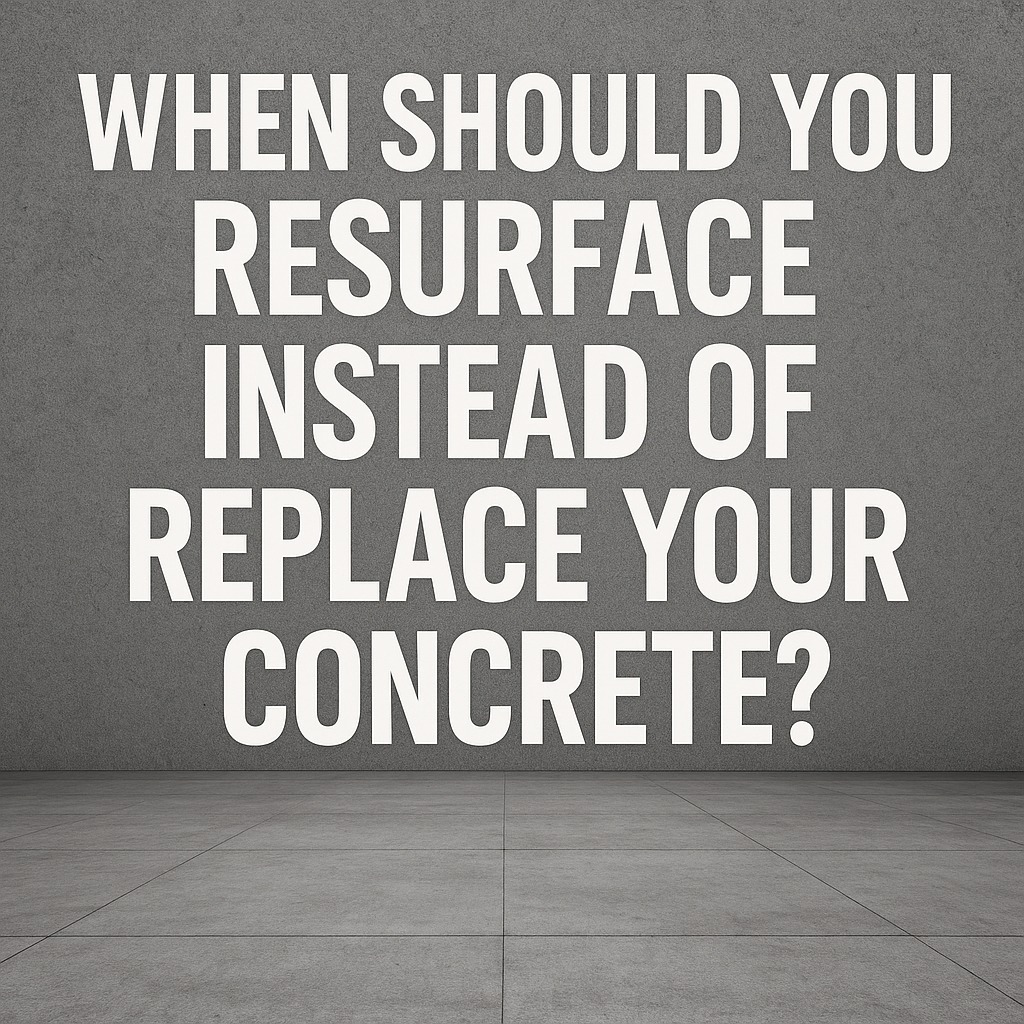
-
-
Concrete resurfacing gives new life to existing concrete without the need for full replacement.
-
It’s a cost-effective choice for fixing small damages, cracks, or changing colors.
-
A full replacement is required for serious structural problems, like large cracks or a damaged base.
-
Resurfacing provides stylish options to enhance the appearance of your property.
-
By checking your concrete’s condition, you can make an informed decision between resurfacing and replacement.
-
Resurfacing is better for the environment than replacing concrete completely.
Introduction
Making the right choice between concrete resurfacing and replacement is important for property owners. Everyone wants solutions that are cheap and last a long time. Concrete resurfacing can repair surfaces and solve minor problems while giving you design choices to improve your property’s look. On the other hand, replacement may be needed for serious structural problems. However, resurfacing is a smart choice if your surfaces are still in good condition. It’s crucial to understand the differences between these two options. This way, you can maintain the strength and beauty of your property.
Understanding Concrete Resurfacing and Replacement
Concrete resurfacing and replacement are two options to repair worn or damaged concrete. Resurfacing adds a thin layer on top of the existing concrete. This can make it look better and work well while still being strong. Replacement means taking out all of the old concrete and putting in a new slab. This option is for more serious problems with the structure.
Choosing an option depends on the level of damage. It also relies on how you want it to look and how you will use the surface later. Each choice has its benefits that fit different needs.
What is Concrete Resurfacing?
Concrete resurfacing can breathe new life into old or damaged concrete surfaces. It involves putting a thin layer of cement-based materials over the existing surface. This method works well for surfaces with minor issues. It helps make them look better without the high cost and trouble of a full replacement. Concrete resurfacing is an affordable choice for driveways, patios, and pool decks that are still in good condition.
One big benefit of this process is the design options it gives. This process is known as decorative concrete resurfacing. It allows homeowners to add different textures, colors, and patterns. With this, plain concrete can become a beautiful highlight.
Concrete resurfacing makes a solid new surface. It can handle heavy traffic and various weather. When you prepare well and use good materials, this process blends nicely with the existing concrete. It can also increase the surface’s life and improve the appearance of your property.
Key Differences Between Resurfacing and Replacing Concrete
Choosing between concrete resurfacing and concrete replacement depends on a few factors. Here is a table that shows the differences:
Feature
Concrete Resurfacing
Concrete Replacement
Cost
More cost-effective
Expensive because of labor and materials
Structural Issues
Good for minor damage
Needed for severe structural issues
Appearance
Improved with decorative options
Provides a fresh, uniform slab
Durability
Lasts long with proper maintenance
Very durable but expensive
Time
Quick and less invasive
Takes a lot of time
If your surfaces are in good condition, resurfacing is usually a better option. However, if you have problems like a damaged subbase or several cracks, you should consider replacement. Each method has its own needs.
Assessing the Condition of Your Concrete
Evaluating your concrete is an important first step. You must decide if resurfacing or complete replacement is the best solution. Begin by looking for signs of deterioration. This includes checking for cracks, spalling, or discoloration.
You should check how strong the surface is. If the concrete looks good and has just a few minor flaws, it can be a good choice for resurfacing. However, if you notice a lot of damage, large voids, or other big issues, you might need to think about a complete replacement. This is key to keeping it safe and durable in the long run.
Signs Your Concrete May Need Resurfacing
Your concrete may need resurfacing if you notice several signs. You might see small cracks, discoloration, or some spalling. These problems can make the surface look less attractive, but they do not harm its strength. It is normal for older concrete to show these signs after enduring weather or regular use.
Concrete that is still in good condition but looks old or not nice is ideal for resurfacing. If the main structure is strong, adding a new layer on top can improve how it looks and works.
Concrete resurfacing can make your surface last longer. It fixes small problems and keeps bigger issues from appearing. If you see any minor wear, resurfacing is a wise option. It is practical, saves money, and can improve the look of your concrete.
When Replacement is the Only Option
Concrete replacement is often the best choice when there are big problems that affect safety or how the surface is used. If you see several cracks, large holes, or a lot of spalling, these issues may be too serious to fix. A complete replacement can address these important structural problems.
If there is a problem, such as soil erosion or a weak subbase, simply resurfacing the top will not solve the issues. Replacing the slab makes sure that the new concrete is put on a strong foundation. This can help it last longer and reduce risks.
If the concrete has sagged a lot or if you notice moisture damage, it is time to replace it. This level of damage is too severe for resurfacing. Replacing the concrete will solve the problem now and provide a strong and safe surface for the long run.
Benefits of Resurfacing Your Concrete
Resurfacing your concrete has many benefits. This is especially true if the existing concrete is in good condition. It helps the concrete last longer and improves its appearance. It can also repair small damages.
Resurfacing is great for the environment. It requires less material and creates less waste. Homeowners have many decorative choices to make their space look new and attractive. This allows them to enjoy a fresh design without the high cost or environmental effects of full replacement.
Cost-Effectiveness Compared to Replacement
One big advantage of concrete resurfacing is that it is cheaper than replacing the entire surface. Resurfacing allows property owners to fix and refresh their surfaces for much less than removing and pouring new concrete. This makes it a better choice for small repairs or updates.
Concrete resurfacing helps you save money on labor and completes the project faster. Changing out old concrete means a lot of work. You have to break it apart and may need to fix plumbing or utility issues. This can be expensive and take a lot of time. Resurfacing skips these extra steps.
Concrete that is resurfaced can last a long time if you take care of it. It gives homeowners a way to fix small damages without spending much money. Resurfacing is a smart choice for saving money.
Environmental Benefits of Resurfacing
Concrete resurfacing is a better option for the environment than replacing concrete. It uses the existing concrete, which means there is less need for new materials. This practice helps reduce the environmental impact caused by making and transporting new materials.
This method creates less waste. It cuts down the need to throw away big pieces of concrete. This is great for people who want to support sustainability in building or fixing things.
Resurfacing has many good benefits for the environment. It is a smart choice for homeowners. They can fix signs of deterioration while also cutting down carbon emissions and lessening waste in landfills. Resurfacing is not just a good option; it is also a great way to keep surfaces strong and lasting.
Conclusion
In conclusion, whether to resurface or replace your concrete can affect your budget and how long your surfaces last. Understanding the main differences between these choices is important. You should look for signs that your concrete needs attention and consider the benefits of resurfacing. This will help you make a smart choice that fits your style and budget. Resurfacing is often cheaper and better for the planet because it cuts down on waste. If you’re unsure about the state of your concrete or need help figuring out what to do, talking to a professional can guide you. This way, you can make sure your investment gives you the best outcome. It’s okay to ask for help and find out what you can do for your concrete surfaces!
Frequently Asked Questions
How long does concrete resurfacing last compared to replacement?
Concrete resurfacing can last a long time, usually around 10 to 15 years or even more with proper care. While a full replacement can last between 25 to 50 years, resurfacing is a good choice to maintain your concrete. It also helps you save money by not needing to replace everything completely.
Can all types of concrete surfaces be resurfaced?
Not every concrete surface can be resurfaced. If the concrete has a lot of spalling, discoloration, or big structural problems, it needs more repair work, like being replaced. However, decorative concrete resurfacing and overlays are perfect for strong surfaces that have minor flaws. This process helps improve the look of the concrete and makes it perform better, too.
What are the best conditions for resurfacing concrete in Australia?
The best times to resurface concrete in Australia are when the weather is mild. You want to avoid high moisture and significant erosion. It’s ideal to work on surfaces that are stable and not facing heavy traffic. A good preparation is important. This helps the resurfacing material stick well to the old surface.
-
